Posts Tagged ‘Dry flies’
{{start}}
If there is a secret to bass fly fishing, and a useful dry fly technique for other native fish species, its got to be putting your fly in the zone and keeping it there for as long as you can. With dry flies that’s fairly easy. Cast it right into the snags or above the margins of the weed beds and hold it there without drag for as long as you can. If nothing happens then just give the fly a little wiggle so that it creates rings on the surface of the water and wait again. Repeat this process a few times until your satisfied that the structure you are covering doesn’t hold an interested fish or until the fly is out of the zone. If fishing static doesn’t work than a great alternative is to position yourself so that you can fish along the structure and then strip the dry flies in using a variety of speeds twitches and pauses.
{{end}}
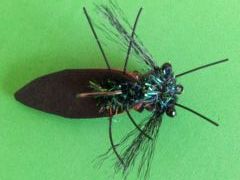
{{+1}}Foam cicada – Chatto’s ‘black prince’{{-1}}
{{start}}
This fly sits well into the surface film like the natural and has a very realistic profile when viewed from below. I have made it smaller than the natural on purpose as flies tied as big as the natural are frustratingly cumbersome to cast on #8 weight outfits that are my preference of the target species mentioned above. The fly lands with a good audible fish attracting 'plop' and with its outstretched wings that are only about half as long as the natural still wiggle with the slightest movement in a very enticing way.{{end}}
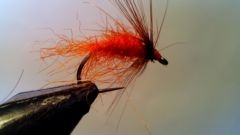
{{+1}}Carrot dry fly{{-1}}
{{start}}
Tied with natural seals fur it is a fly that sits well on the water and easily sheds water with a snappy false cast.{{end}}

{{+1}}Plume{{-1}}
{{start}}
This is an incredible fly for delicate presentations to mayfly feeders ... the waters of the Korka had mayfly hatching but I was having trouble in finding a fly that didn’t spook them. Remembering that browns were behaving in a similar way in the training session I mentioned above I swapped over to the plume and ultimately did pretty well for the session coming in 10th out of 28 competitors.{{end}}
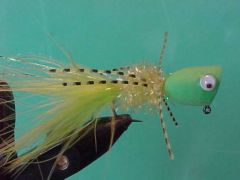
{{+1}}Popper – bass foam head{{-1}}
{{start}}
The fist and most obvious is when they are actively feeding. At those times bass can have an appetite for everything from nymphs, yabbies, small fish, shrimp, worms, lizards, frogs, grasshoppers, cicadas, beetles and for that matter almost anything that will fit in their mouth it's not surprising that a popper dropped in their line of sight and looking like something alive often gets their attention. Bass are binge feeders and are by no way picky when it comes to feeding time.{{end}}
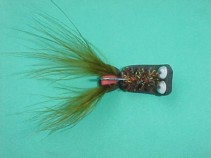
{{+1}}Wiggle frog – Chatto’s original{{-1}}
{{start}}
You can fish this fly on an intermediate or faster sinking line but my preference is to fish it on a floating line so that it swims just below the surface. On a floating line the best technique for fishing the fly is to give it one or two short strips and then rest it for a moment whilst it comes back to the surface. Rest it there for a few more seconds and then repeat the process.{{end}}
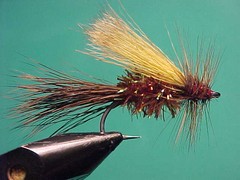
{{+1}}Bass stimulator – Chatto’s tie{{-1}}
{{start}}
For a long time I simply sized up my trout stimulator and used them on bass unfortunately they just didn't offer bass a big enough morsel and even though they were bigger than anything I would use for trout they still landed too softly ... not announcing their presence to the bass. A while back I got round to addressing the problems and after a reasonable amount of experimentation came up with this version of a stimulator which ticks all the boxes.{{end}}
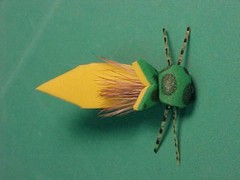
{{+1}}Bass foam hopper{{-1}}
{{start}}
When I converted my trout foam hopper for use as a bass and tropical fly fishing I added a sparkle chenille under-body and grossed it up dramatically so that it would withstand the aggressive nature of fish like Australian bass and tropical species such as mangrove jack.{{end}}

{{+1}}Claret daddy{{-1}}
{{start}}
This is a cross between an English claret hopper and a daddy long legs fly and it fills a gap in my fly box for a buggy looking search pattern when there are a few terrestrials about but no clear consistency of species. Because of its size and the way that it floats this fly is also useful as a top fly when either Loch Style Dry Fly fishing or as an indicator when fishing a team of dry smut flies or other small flies.{{end}}
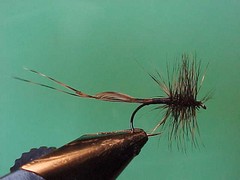
{{+1}}Wonder tail dun or spinner{{-1}}
{{start}}
The Wonder Tail Dun or Spinner is a generic representation for members of the “Leptophlebiidae” family of Mayflies and particularly useful for the various Highland Duns & Spinners, which are members of the “Oniscigastridae” genus. Hatches generally occurs between the months of October and March.{{end}}
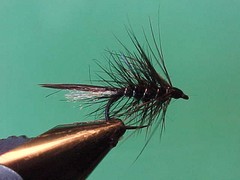
{{+1}}White arse black zulu{{-1}}
{{start}}
The Zulu tied with a black hackle body and a black tail has origins that go back to circa 1600 England. This fly deviates from the standard a little and has a white under-tail of antron tied in to represents a trailing shuck, seals fur dubbing and a soft hackle at the front so if it is used as a loch fly it has some movement and a couple of trigger points.{{end}}













